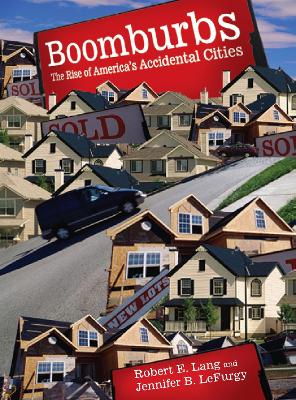James A. Johnson Metro
2 total works
Edgeless cities are a sprawling form of development that accounts for the bulk of office space found outside of downtowns. Every major metropolitan area has them: vast swaths of isolated buildings that are neither pedestrian friendly, nor easily accessible by public transit, and do not lend themselves to mixed use. While critics of urban sprawl tend to focus on the social impact of "edge cities" -developments that combine large-scale office parks with major retail and housing -edgeless cities, despite their ubiquity, are difficult to define or even locate. While they stay under the radar of critics, they represent a significant departure in the way American cities are built and are very likely the harbingers of a suburban future almost no one has anticipated.
Edgeless Cities explores America's new metropolitan form by examining the growth and spatial structure of suburban office space across the nation. Inspired by Myron Orfield's groundbreaking Metropolitics (Brookings, 1997), Robert Lang uses data, illustrations, maps, and photos to delineate between two types of suburban office development -bounded and edgeless. The book covers the evolving geography of rental office space in thirteen of the country's largest markets, which together contain more than 2.6 billion square feet of office space and 26,000 buildings: Atlanta, Boston, Chicago, Dallas, Denver, Detroit, Houston, Los Angeles, Miami, New York, Philadelphia, San Francisco, and Washington.
Lang discusses how edgeless cities differ from traditional office areas. He also provides an overview of national, regional, and metropolitan office markets, covers ways to map and measure them, and discusses the challenges urban policymakers and practitioners will face as this new suburban form continues to spread.
Until now, edgeless cities have been the unstudied phenomena of the new metropolis. Lang's conceptual approach reframes the current thinking on suburban sprawl and provides a valuable resource for future policy discussions surrounding smart growth issues.
Edgeless Cities explores America's new metropolitan form by examining the growth and spatial structure of suburban office space across the nation. Inspired by Myron Orfield's groundbreaking Metropolitics (Brookings, 1997), Robert Lang uses data, illustrations, maps, and photos to delineate between two types of suburban office development -bounded and edgeless. The book covers the evolving geography of rental office space in thirteen of the country's largest markets, which together contain more than 2.6 billion square feet of office space and 26,000 buildings: Atlanta, Boston, Chicago, Dallas, Denver, Detroit, Houston, Los Angeles, Miami, New York, Philadelphia, San Francisco, and Washington.
Lang discusses how edgeless cities differ from traditional office areas. He also provides an overview of national, regional, and metropolitan office markets, covers ways to map and measure them, and discusses the challenges urban policymakers and practitioners will face as this new suburban form continues to spread.
Until now, edgeless cities have been the unstudied phenomena of the new metropolis. Lang's conceptual approach reframes the current thinking on suburban sprawl and provides a valuable resource for future policy discussions surrounding smart growth issues.
A glance at a list of America's fastest growing ""cities"" reveals quite a surprise: most are really overgrown suburbs. Places such as Anaheim, California, Coral Springs, Florida, Naperville, Illinois, North Las Vegas, Nevada, and Plano, Texas, have swelled to big-city size with few people really noticing -including many of their ten million residents. These ""boomburbs"" are large, rapidly growing, incorporated communities of more than 100,000 residents that are not the biggest city in their region. Here, Robert E. Lang and Jennifer B. LeFurgy explain who lives in them, what they look like, how they are governed, and why their rise calls into question the definition of urban. Located in over twenty-five major metro areas throughout the United States, numerous boomburbs have doubled, tripled, even quadrupled in size between census reports. Some are now more populated than traditional big cities. The population of the biggest boomburb -Mesa, Arizona -recently surpassed that of Minneapolis and Miami. Typically large and sprawling, boomburbs are ""accidental cities,"" but not because they lack planning. Many are made up of master-planned communities that have grown into one another. Few anticipated becoming big cities and unintentionally arrived at their status. Although boomburbs possess elements found in cities such as housing, retailing, offices, and entertainment, they lack large downtowns. But they can contain high-profile industries and entertainment venues: the Los Angeles Angels of Anaheim and Arizona Cardinals are among over a dozen major-league sports teams who play in the boomburbs. Urban in fact but not in feel, these drive-by cities of highways, office parks, and shopping malls are much more horizontally built and less pedestrian friendly than most older suburbs. And, contrary to common perceptions of suburbia, they are not rich and elitist. Poverty is often seen in boomburb communities of small single-family homes, neighborhoods that once represented the American dream. Boomburbs are a quintessential American landscape, embodying much of the nation's complexity, expansiveness, and ambiguity. This fascinating look at the often contradictory world of boomburbs examines why America's suburbs are thriving and how they are shaping the lives of millions of residents.

